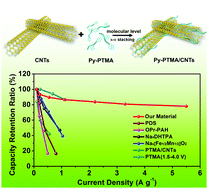当前位置:
X-MOL 学术
›
Mater. Chem. Front.
›
论文详情
Our official English website, www.x-mol.net, welcomes your
feedback! (Note: you will need to create a separate account there.)
Molecular-level anchoring of polymer cathodes on carbon nanotubes towards rapid-rate and long-cycle sodium-ion storage†
Materials Chemistry Frontiers ( IF 6.0 ) Pub Date : 2018-07-10 00:00:00 , DOI: 10.1039/c8qm00163d Yuxiang Hu 1, 2, 3, 4, 5 , Kai Zhang 3, 4, 5 , Han Hu 1, 2, 3, 4, 5 , Songcan Wang 1, 2, 3, 4, 5 , Delai Ye 1, 2, 3, 4, 5 , Michael J. Monteiro 3, 4, 5 , Zhongfan Jia 3, 4, 5 , Lianzhou Wang 1, 2, 3, 4, 5
Materials Chemistry Frontiers ( IF 6.0 ) Pub Date : 2018-07-10 00:00:00 , DOI: 10.1039/c8qm00163d Yuxiang Hu 1, 2, 3, 4, 5 , Kai Zhang 3, 4, 5 , Han Hu 1, 2, 3, 4, 5 , Songcan Wang 1, 2, 3, 4, 5 , Delai Ye 1, 2, 3, 4, 5 , Michael J. Monteiro 3, 4, 5 , Zhongfan Jia 3, 4, 5 , Lianzhou Wang 1, 2, 3, 4, 5
Affiliation

|
Nitroxide radical polymers (NRPs) have attracted increasing research interest as promising cathode materials for sodium ion batteries, primarily owing to their high-voltage (ca. 3.47 V vs. Na+/Na), environment compatibility, low-cost, and rich resources. However, such NRP cathodes are subjected to low rate-capacity and poor cycling stability because of their inferior conductivity and dissolubility in the electrolyte. Herein, we report a “molecular glue” strategy to anchor pyrene functionalized NRPs on a highly condutive carbon nanotube (CNT) matrix through π–π interactions between the pyrene functional groups and CNTs. As such, the NRP layer is homogeneously “glued” on the carbon substrates and the non-covalent interaction with CNTs drastically improves the insolubility and electric conductivity of the composite. Benefiting from these structural merits, the new nanocomposite exhibits a record cyclability (92% capacity retention at a high current density of 2.2 A g−1 after 6000 cycles) and remarkable rate capability (78 mA h g−1 at 5.5 A g−1) when evaluated as a high-voltage cathode material for SIBs. This work demonstrates the importance of rational hybridization of radical polymers and carbon substrates for enhanced electrochemical performance and provides insightful guides for designing high-performance polymer-based composites for energy storage applications.
中文翻译:

碳纳米管上的聚合物阴极在分子水平上的锚定,以实现快速和长周期的钠离子存储†
作为有前景的钠离子电池正极材料,一氧化氮自由基聚合物(NRP)引起了越来越多的研究兴趣,这主要是由于它们的高电压(约3.47 V vs. Na +/ Na),环境兼容性,低成本和丰富的资源。然而,由于这种NRP阴极的电导率和在电解质中的溶解性较差,因此它们具有低倍率容量和较差的循环稳定性。本文中,我们报告了一种“分子胶”策略,可通过through官能团与CNT之间的π-π相互作用将pyr官能化的NRP锚定在高导热性碳纳米管(CNT)基质上。这样,NRP层被均匀地“粘合”在碳基材上,并且与CNT的非共价相互作用极大地改善了复合材料的不溶性和导电性。受益于这些结构优点,新的纳米复合材料具有创纪录的可循环性(在2.2 A g -1的高电流密度下容量保持率达到92%)后6000个循环)和显着的速率能力(78毫安汞柱-1在5.5克-1时,作为SIB的高电压阴极材料进行评价)。这项工作证明了自由基聚合物和碳底物合理杂化对于增强电化学性能的重要性,并为设计用于储能应用的高性能聚合物基复合材料提供了有见地的指导。
更新日期:2018-07-10
中文翻译:

碳纳米管上的聚合物阴极在分子水平上的锚定,以实现快速和长周期的钠离子存储†
作为有前景的钠离子电池正极材料,一氧化氮自由基聚合物(NRP)引起了越来越多的研究兴趣,这主要是由于它们的高电压(约3.47 V vs. Na +/ Na),环境兼容性,低成本和丰富的资源。然而,由于这种NRP阴极的电导率和在电解质中的溶解性较差,因此它们具有低倍率容量和较差的循环稳定性。本文中,我们报告了一种“分子胶”策略,可通过through官能团与CNT之间的π-π相互作用将pyr官能化的NRP锚定在高导热性碳纳米管(CNT)基质上。这样,NRP层被均匀地“粘合”在碳基材上,并且与CNT的非共价相互作用极大地改善了复合材料的不溶性和导电性。受益于这些结构优点,新的纳米复合材料具有创纪录的可循环性(在2.2 A g -1的高电流密度下容量保持率达到92%)后6000个循环)和显着的速率能力(78毫安汞柱-1在5.5克-1时,作为SIB的高电压阴极材料进行评价)。这项工作证明了自由基聚合物和碳底物合理杂化对于增强电化学性能的重要性,并为设计用于储能应用的高性能聚合物基复合材料提供了有见地的指导。











































 京公网安备 11010802027423号
京公网安备 11010802027423号